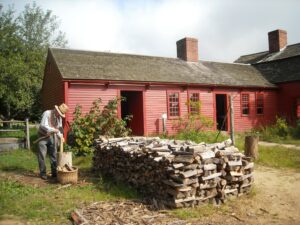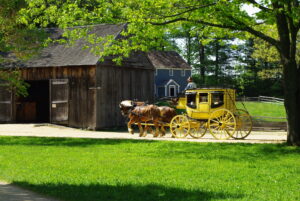By Sharon Oliver
Contributing Writer
STURBRIDGE – Whenever one feels the urge to unplug from the busyness of modern times, a trip to Old Sturbridge Village in the picturesque town of Sturbridge may be the ticket. Old Sturbridge Village is a recreation of rural New England during the 1790s through 1830s and is one of the largest villages in the state, covering 200 acres of the last vestiges of colonialism.
The living museum has over 50 buildings, some of which were moved from other parts of New England and contain historically accurate furnishings and artifacts. There are also five gardens, historical exhibits, heritage-breed animals, and costumed historians acting out the jobs and tasks from the time period while answering any questions asked of them.

Old Sturbridge Village is divided into three main sections.
The Countryside
- Freeman Farmhouse – a typical New England farm of approximately 70 acres with a barn, outbuildings, and fields
- Blacksmith Shop—a shop where farm implements and other hardware were made and repaired and horses and oxen were shod
- Bixby House —home of the blacksmith
- Cooper Shop—where wooden barrels, buckets, and pails were made
- Pottery Shop—potters made useful items out of local clay, such as milk pans, mugs, crocks, flowerpots, and mixing bowls
- District School —one-room school
- Covered Bridge—Covered bridges extended the longevity of wooden bridges in the harsh New England weather

Photo/Library of Congress/Carol M. Highsmith
The Center Village
- Friends Meetinghouse—a meetinghouse of the Religious Society of Friends, known as Quakers
- Center Meetinghouse—churches often served as a location for town meetings, elections, lectures, and political events
- Tin Shop—tin imported from England was used to make an array of household goods
- Salem Towne House—a prosperous farmer’s home
- Law Office—a small, free-standing office of a lawyer
- Parsonage —home of a minister and his family
- Asa Knight Store—a country store, transported from its original location in Vermont
- Thompson Bank—a bank that was originally located in Thompson, Connecticut
- Fenno House—a historic house with exhibits that highlight domestic textile production
- Fitch House—a residence exhibit that highlights children and family life
- Small House—a small home based on those of less affluent families and renters, which was built from scratch at the village using period-appropriate techniques.
- Printing Office
- Cider Mill—a horse-powered mill used for the production of hard cider
- Shoe Shop—a historic ten-footer, which was a small backyard shop structure built in the 18th and 19th centuries in New England to serve as a shoemaker’s shop.
- Town Pound—for the confinement of livestock found wandering loose
- Bullard Tavern—an early 19th-century tavern room
- The Stagecoach—a stagecoach marked “Hartford & Worcester” which makes trips through Center Village
Mill Neighborhood
This neighborhood has a gristmill with waterpower to turn a 3,000-pound millstone for grinding grain. The sawmill is a working replica of an “up-and-down” sawmill powered by a reaction-type waterwheel and the Carding Mill is a water-driven facility used to prepare wool for spinning.

Photo/Wikimedia Commons/Dale E. Martin
Tami B wrote on Tripadvisor: “What a terrific experience! The characters were friendly and happy to share their knowledge as well as encouraging picture-taking. The grounds were clean and well-maintained for walking. Restrooms were clean, and easily accessible and available at various spots along the exhibits. You would really need 4 to 5 hours to see everything. We would definitely go back!”
A trip to Old Sturbridge Village is a must for anyone, young or old, interested in learning more about what New England colonial life was like 200 years ago or just to escape from the hustle and bustle of these modern times if only for a moment.
RELATED CONTENT:
Berkshires offer a lot of attractions for a quick getaway trip
Massachusetts snowmobile trail system stretches across the state












